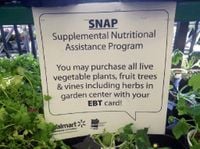Across the United States, millions of families are bracing for sweeping changes to the Supplemental Nutrition Assistance Program (SNAP), often referred to as food stamps, as new federal rules and funding cuts take effect in the coming weeks. The Trump administration’s “One Big Beautiful Bill Act,” signed into law in July 2025, has set off a wave of uncertainty and anxiety for recipients, social service agencies, and local communities—particularly in states like New York, New Mexico, New Hampshire, and Vermont, where the impact is expected to be immediate and profound.
On October 3, 2025, the federal agency overseeing SNAP announced the abrupt cancellation of waivers that had allowed states such as New York to suspend work requirements for certain recipients. As reported by New York Focus, this move accelerates the timeline for enforcing work rules from March 2026 to early November 2025, giving counties just weeks to prepare. The new requirements will force able-bodied adults aged 18 to 54 without dependents under 18 to certify that they are working, volunteering, or studying at least 80 hours per month—or risk losing their benefits. Upon renewal, the rules will extend to adults up to age 64 without dependents under 14.
“I’m sitting with the managers and brainstorming what we can do to stay ahead of the storm. Every idea is going to be on the table,” said Kira Pospesel, commissioner of Greene County’s social services department in the Catskills, in an interview with New York Focus. Her department, like many others, is already stretched thin by seasonal demands for heating assistance and faces a daunting increase in workload as SNAP rules change.
Phil Church, Oswego county administrator and president of the New York State Association of Counties, echoed these concerns. “We’re going to have to have all hands on deck for this,” Church told New York Focus. His county typically assigns 15 staffers to SNAP administration, but now expects to need 39 to meet the new demands—at a time when federal funding for SNAP administrative costs is being slashed and counties are struggling to balance their budgets amid broader Trump-era cuts.
The July law not only expands work requirements but also decreases federal funding for SNAP administration, pushing a greater share of costs onto state and local governments. Nearly 3 million New Yorkers rely on SNAP, with the average household receiving $376 per month. Nearly half a million receive Women, Infants, and Children (WIC) benefits, which provide nutritional support to pregnant people, new mothers, and young children. The financial and administrative strain is compounded by the ongoing government shutdown, which, if unresolved, could suspend SNAP and WIC funding as soon as November 2025.
Ryan Healy, advocacy manager for Feeding New York State, highlighted another looming problem: the Trump administration’s recent elimination of the annual food insecurity survey, which had been conducted since the 1990s. “When you’re looking to avoid accountability for your bad policy decisions, you stop collecting data,” Healy told New York Focus. “It’s going to make it even harder to evaluate the magnitude of these unprecedented changes.”
In New Mexico, as many as 32,000 residents could see their SNAP eligibility affected by a change in how energy assistance payments are factored into benefit calculations. According to the New Mexico Health Care Authority, beginning November 1, 2025, only households with members aged 60 or over, or with disabilities, will automatically receive the $408 standard utility deduction from their income calculations. Other households must now provide utility bills or additional documentation to qualify for the deduction, a shift that could reduce benefits or disqualify some recipients altogether. “We’re reaching out early so families have time to prepare,” said Niki Kozlowski, director of the Income Support Division at the HCA, in a statement. “If you’re unsure how this affects you, please contact us now, before your next renewal date, so we can walk you through what you may need to provide.”
The human cost of these changes is already being felt in New England, where stories from New Hampshire and Vermont illustrate just how vital SNAP is for families and individuals living on the edge. According to the Valley News, Madeleine Campbell of Windsor, New Hampshire, relies on SNAP to buy fresh produce for her family while caring for her husband, who is undergoing kidney failure treatment. “I really, really love the ability to shop at farmers markets with SNAP. It so incentivizes buying produce,” Campbell said. Farmers markets in Lebanon and Norwich offer matching programs, such as Crop Cash and Granite State Market Match, which stretch SNAP dollars further and help families put nutritious food on the table.
But Campbell’s family, like many others, faces uncertainty as the new work requirements threaten their eligibility. Because she is a full-time caregiver and does not meet the minimum work requirement of 30 hours a week at federal minimum wage, she fears losing her portion of the benefits. “We will have to make some decisions about how we can change what we’re eating,” she told Valley News, noting they’d likely need to rely more on dry goods and fewer fresh vegetables.
For Sofia Lesage, a part-time library clerk in White River Junction, SNAP benefits have been a lifeline. After moving to a new apartment without an electric bill, her monthly SNAP benefit dropped from $292 to $42, despite her rent increasing by 10%. “I’m poor as dirt,” Lesage said. She risks losing her benefits entirely due to the reinstated work requirement, which she cannot meet because of chronic back pain and mental health challenges. The farmers market’s matching program has helped her continue to access healthy food, but the future remains uncertain.
Seniors, too, are feeling the squeeze. Nancy Jarvis, 73, of White River Junction, uses a combination of SNAP and federally funded Farm to Family coupons to buy produce at local markets. “You’re going to end up sick if you don’t get the right nutrition in your food,” Jarvis said. “You don’t want to go take vitamin pills, I’d rather use food.” She worries about the Trump administration’s threats to cut Social Security and SNAP, especially as the new law means SNAP will no longer be adjusted for cost of living.
Fraud is another growing concern. In June 2025, a New York SNAP recipient lost her entire $292 monthly benefit due to card skimming—a scam that has become more common as states lag in adopting more secure chip-enabled cards. Stolen SNAP funds are no longer reimbursed after Congress failed to extend funding for reimbursements late last year, leaving vulnerable recipients without recourse.
Advocates like Diana Ramos of the Urban Justice Project are calling on state leaders to step up. “We need to be the role models of this country and say New York state stepped up,” Ramos urged, suggesting the state raise taxes on the wealthy to backfill federal cuts. “I’d like to see the state offer funding.”
As the nation heads into winter, the fate of SNAP—and the millions who depend on it—hangs in the balance. For many, the coming weeks will determine not just what’s on their dinner table, but whether they can put food on it at all.





